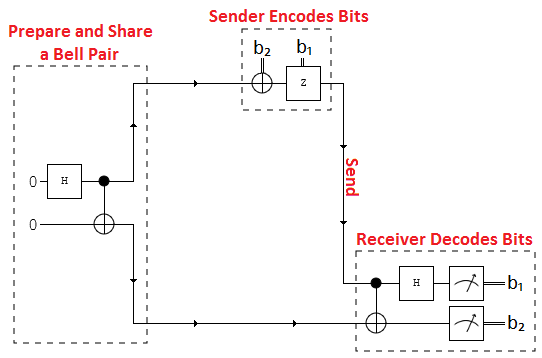Superdense coding

In quantum information theory, superdense coding is a technique used to send two bits of classical information using only one qubit.[1][2] It is the inverse of quantum teleportation, which sends one qubit with two classical bits.[3] Both superdense coding and quantum teleportation require, and use up, entanglement between the sender and receiver in the form of Bell pairs.
Overview
Suppose Alice would like to send classical information to Bob using qubits, instead of classical bits. Alice would encode the classical information in a qubit and send it to Bob. After receiving the qubit, Bob recovers the classical information via measurement. The question is: how much classical information can be transmitted per qubit? Since non-orthogonal quantum states cannot be distinguished reliably , one would guess that Alice can do no better than one classical bit per qubit. Holevo's theorem discusses this bound on efficiency. Thus, there is no advantage gained in using qubits instead of classical bits . However, with the additional assumption that Alice and Bob share an entangled state, two classical bits per qubit can be achieved. The term superdense refers to this doubling of efficiency. Also, it can be proved that the maximum amount of classical information that can be sent (even while using entangled state) using one qubit is 2 bits .
Details
Crucial to this procedure is the shared entangled state between Alice and Bob, and the property of entangled states that a (maximally) entangled state can be transformed into another state via local manipulation.
Suppose parts of a Bell state, say
are distributed to Alice and Bob. The first subsystem, denoted by subscript A, belongs to Alice and the second, B, system to Bob. By only manipulating her particle locally, Alice can transform the composite system into any one of the Bell states (entanglement cannot be broken using local operations):
- Suppose Alice wants to send the classical bits 00.
Then she will perform identity unitary operation on her particle. Her entangled qubit remains unchanged. The resultant tangled qubit would be
- Suppose Alice wants to send the bits "01". Then she will perform unitary operation.
is like a quantum NOT gate. After the application of unitary gate the resultant entangled quantum state would be
- Suppose Alice wants to send the bits "10". Then she will perform unitary operation.
After the application of unitary gate, the resultant entangled quantum state would be
- Suppose Alice wants to send the bits "11". Then she will perform unitary operation.
After the application of unitary gate the resultant entangled quantum state would be
are Pauli gates. are called Bell states.
Now, if Bob wants to find which classical bits Alice wanted to send he will perform the unitary operation followed by unitary operation on the entangled qubit.
- If the resultant entangled qubit was then after the application of the above unitary operations the entangled qubit will become
- If the resultant entangled qubit was then after the application of the above unitary operations the entangled qubit will become
- If the resultant entangled qubit was then after the application of the above unitary operations the entangled qubit will become
- If the resultant entangled qubit was then after the application of the above unitary operations the entangled qubit will become
So, depending on the message she would like to send, Alice performs one of the four local operations given above and sends her qubit to Bob. By performing a projective measurement in the Bell basis on the two particle system, Bob decodes the desired message.
If some mischievous person, such as Eve, intercepts Alice's qubit en route to Bob, all that is obtained by Eve is part of an entangled state. Therefore, no useful information whatsoever is gained by Eve unless she can interact with Bob's qubit.
General dense coding scheme
General dense coding schemes can be formulated in the language used to describe quantum channels. Alice and Bob share a maximally entangled state ω. Let the subsystems initially possessed by Alice and Bob be labeled 1 and 2, respectively. To transmit the message x, Alice applies an appropriate channel
on subsystem 1. On the combined system, this is effected by
where I denotes the identity map on subsystem 2. Alice then sends her subsystem to Bob, who performs a measurement on the combined system to recover the message. Let the effects of Bob's measurement be Fy. The probability that Bob's measuring apparatus registers the message y is
Therefore, to achieve the desired transmission, we require that
where δxy is the Kronecker delta.
References
- ↑ Bennett, C.; Wiesner, S. (1992). "Communication via one- and two-particle operators on Einstein-Podolsky-Rosen states". Physical Review Letters. 69 (20): 2881. doi:10.1103/PhysRevLett.69.2881.
- ↑ Michael A. Nielsen; Isaac L. Chuang (9 December 2010). "2.3 Application: superdense coding". Quantum Computation and Quantum Information: 10th Anniversary Edition. Cambridge University Press. p. 97. ISBN 978-1-139-49548-6.
- ↑ Mark Wilde (18 April 2013). Quantum Information Theory. Cambridge University Press. p. 181. ISBN 978-1-107-03425-9.
External links
- Qubits, Quantum Mechanics and Computers Course Notes
- Superdense coding: how to send two bits using one qubit on YouTube by Michael Nielsen
